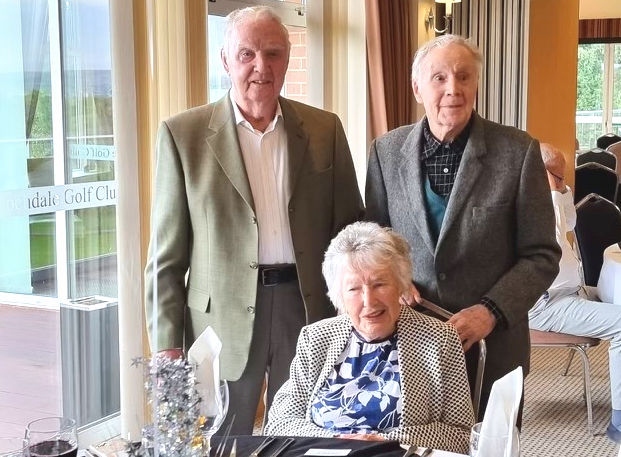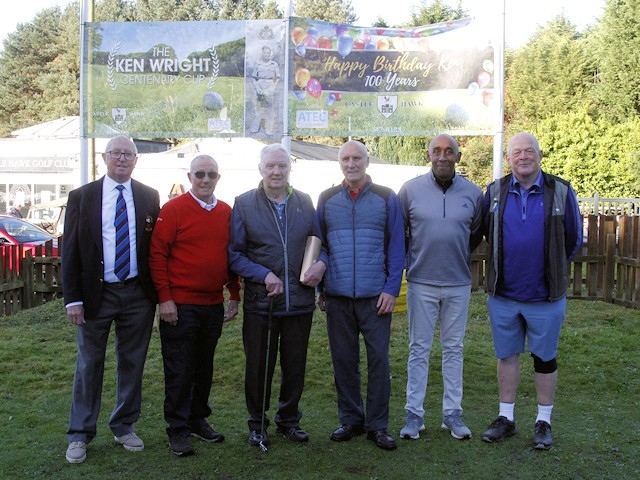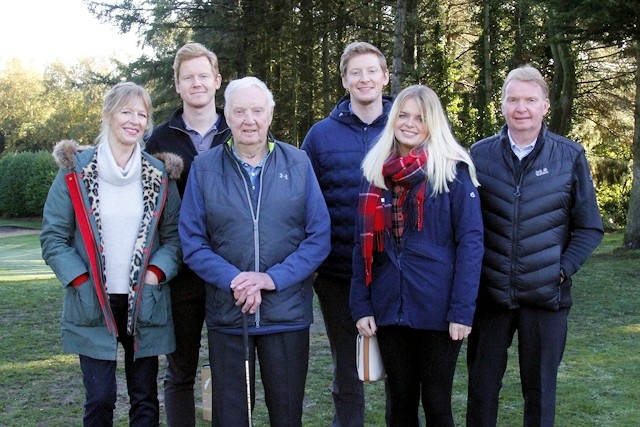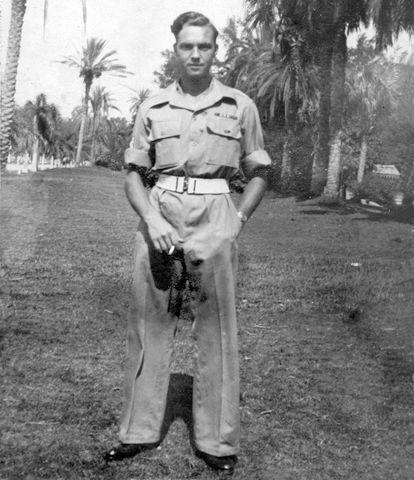D-Day veteran from Rochdale celebrates his 100th birthday
Date published: 18 October 2022

Ken (left) and two of his siblings, Fred, aged 92 and Mary, 95, celebrating Ken’s 100th
A man believed to be Rochdale’s only surviving D-Day veteran has celebrated his 100th birthday with a golf tournament in his honour at Castle Hawk golf club.
Ken Wright was chauffeured in a World War Two jeep to the first hole at the club, where he teed off the tournament – aptly named the Ken Wright Cup.
An officer from his old regiment, the Suffolks, was there to greet him, as well as piper escorts and standard bearers from the British Legion.

It is believed Ken is the only surviving veteran who landed on Sword Beach with the 8th brigade, part of 3rd British Infantry Division; the Royal British Legion has said that Ken is Rochdale’s only D-Day veteran that they are aware of.
In 2016, Ken was appointed to the rank of Chevalier (Knight) in the prestigious Legion of Honour, France’s highest honour.
One of five children, Ken was born to his Rochdale father, Fred, – who served in World War One – and his Shropshire mother, Mary-Ann, on 10 October 1922.
A baker and confectioner, Mary Ann originally moved to Rochdale after responding to an advert in the local paper looking for a trainee cook on Spotland Road. She met Fred after he served in the forces and they married, before welcoming their first child, Mildred, in 1920.
They moved from Belfield Road to Ditton Priors in Shropshire by the time Ken was born, returning to Rochdale when Ken was nine.
He recalled: “My mother was a year older than my father, and she didn’t like that! She was born in 1895 and he in 1896. My sister Ruth was two-and-a-half years younger than me, Mary was two years younger than her, and Fred was the baby, born on the same day as Princess Margaret [in 1930].
“They moved to Shropshire where my father had a small farm given to soldiers after World War One. My uncle Tom also had one. My father knew horses because he’d been in the cavalry but he didn’t make a go of it. He sold it, worked in a quarry before it closed, then they came back to Rochdale and we lived with my auntie.”

Ken attended Newbold Comprehensive, leaving at the age of 14 where he went to work in a cotton mill. After a run in with a lorry on the first day of spring when cycling to work, he made the move into construction before he was called up to the Army on 15 January 1942.
“I had to have 21 stitches in my head and knee. I was laid up for 16 weeks and I never went back,” he said.
Ken was called up to the Suffolk regiment, 1st Battalion, where he served until he was demobbed after five years and one week. He went back into building and plastering, retiring at the age of 65.
He married Nellie Cockcroft, 18, on 20 March 1948, and they had a son, Alan, in 1954. Alan and his wife, Lorraine, have three children, Dean, 36, Adam, 35, and Laura, 30, with Ken’s first great-grandchild on the way.
Ken and Nellie were married until her death at the age of 81, on 20 December 2010.
Ken picked up golf as a hobby when he was 50, thanks to his younger brother, and joined Castle Hawk two years later, after picking up a full set of golf clubs from a second-hand shop for £18 (around £150 in today’s money).
He borrowed a book from the library written by a top golfer and would practise with Fred on Blackstone Edge.
“We used to go to Springfield Park at 4.30am – but we were never the first there!”
Reflecting on his time in the army as a private, Ken revealed he was one of the first soldiers to land on Sword beach during the D-Day landings with the 8th brigade, part of 3rd British Infantry Division.

The 8th brigade consisted of 1st battalion Suffolk regiment (made up of A, B and C companies), 2/East Yorkshire and 1/South Lancashire.
Part of C company, the rifleman sniper believes he may be one of the few survivors still alive today to have landed on the first day – and described finally returning to solid ground as “heaven.”
A spokesperson for the Royal British Legion said that the charity was “aware” of a few D-Day veterans from other regions and platoons who landed on other beaches, but none from Ken’s.
1/Suffolk was the last battalion of the brigade to land, acting as a reserve and with further instructions beyond the taking of the beach itself.
The Suffolks landed at Sword Beach at 8.30am on 6 June and its specific target was to capture two Nazi strongholds just inland. These were a gun emplacement, codenamed Morris, and a battalion HQ defended by machine-gun posts and anti-tank guns, codenamed Hillman.
Although fortunate enough to make it through the war unwounded, Ken did witness many casualties, including that of his best friend, Private John Sidlow, when advancing on a French château when tasked with clearing the town of Colleville-sur-Orne, now Colleville-Montgomery, in Normandy.
“John said he’d been hit. It was dark and I left my rifle and ran across to him. I couldn’t see how badly he was injured, but I could see some blood. I put a bandage round his head and told him to go back to the first aid post, because I didn’t know how badly he was hurt,” Ken recalled.
After Ken returned to where his rifle was, he found a lump of steel: a shell or mortar had landed in his absence.
Later that night, Ken would find out that John had been hit again, this time killing him.
“The Lance Corporal said he was sorry about my mate. I told him he was okay; I’d sent him back to the first aid post, but I was told he was dead: he’d been hit again.”
With the entirety of his section gone, Ken pressed on when he came across another soldier with a wounded leg – Private Jock Chambers - near the hedgerow close to the château.
“Jock had been hit by a piece of shrapnel; his calf was hanging down. I put a field dressing on and said I’d get him to the hedgerow. He asked, ‘why?’ and I told him I was continuing.
“He said ‘You can’t leave me; there’s nobody left.’ It was now becoming daylight so I put him on my back and carried him to the first aid post, as machine gun bullets were splattering up the ground next to me. Jock asked, ‘can you move to your left a wee bit?’ I got him there though.”
After delivering him into the care of the medical offer, Ken was asked if he had eaten before given a meal of steak, peas, gravy and black bread before getting six hours’ sleep in a hayloft.
Another incident – involving a barrel of wine in No Man’s Land and too much to drink – would also potentially save Ken’s life.
“I’d had too much. We heard the German gun fire and I didn’t see or hear the explosion before I was flung through the air. I heard Private Paddy Fisher scream ‘Ken’s had it!’ I responded with, ‘Bloody Ken hasn’t had it!”

After volunteering to unload ammunition, Ken returned to the trench when he was sober, but learned Paddy had been killed by one of their own shells.
In 2008, Ken made his first return to France since the war, where he and his family visited the grave of Private Sidlow.
“I didn’t know what town or cemetery he was buried at,” Ken said. “We were driving when we saw a sign saying there was a British cemetery, so we parked up and went to look. Alan and my grandsons were off – and they somehow walked straight to John’s grave, like they knew where he was.”
Ken fought in every battle with the Suffolks, except for one when he was in hospital with acute tonsillitis for three weeks. He added that someone put his name down for a patrol in Holland, but he declined to take part as he couldn’t swim – none of the volunteers would return.
Recalling the second D-Day landings at Pegasus Bridge, he had been appointed to an anti-tank gun to help relieve the South Lancashire platoon.
Not knowing how to fire and work it, he says it was simple enough to work out. Working his way through the crawl trenches to their supplies, he picked up a shell with a blue nose to load into the gun.
“Shell noses painted blue pierced armour and red were explosive,” he explained. “I wanted to see how the gun worked, so I fit the shell and fired it about two-three hundred yards up the canal where a boat was. It was just below the watermark, and I saw the water bubble and about four or five people jump off.”
Ken found it was a German boat – and that they had been surrounded.
He didn’t tell anyone about it until 2008 when he was told by a general that for years the forces had tried to find out who sank the boat – as none of them could work it out.
He has since returned to Normandy for the 70th and 75th anniversaries of the D-Day landings, and plans to return for the 80th in 2024.
Do you have a story for us?
Let us know by emailing news@rochdaleonline.co.uk
All contact will be treated in confidence.
Most Viewed News Stories
- 1Ask Citizens Advice: How can I keep track of my spending better this year?
- 2Snow and ice warning for Rochdale & Greater Manchester
- 3Police arrest drug driver after pursuit
- 4Century-old town centre pub could soon become apartments
- 5Detectives make an arrest and appeal for more information following fatal stabbing in Rochdale
To contact the Rochdale Online news desk, email news@rochdaleonline.co.uk or visit our news submission page.
To get the latest news on your desktop or mobile, follow Rochdale Online on Twitter and Facebook.


